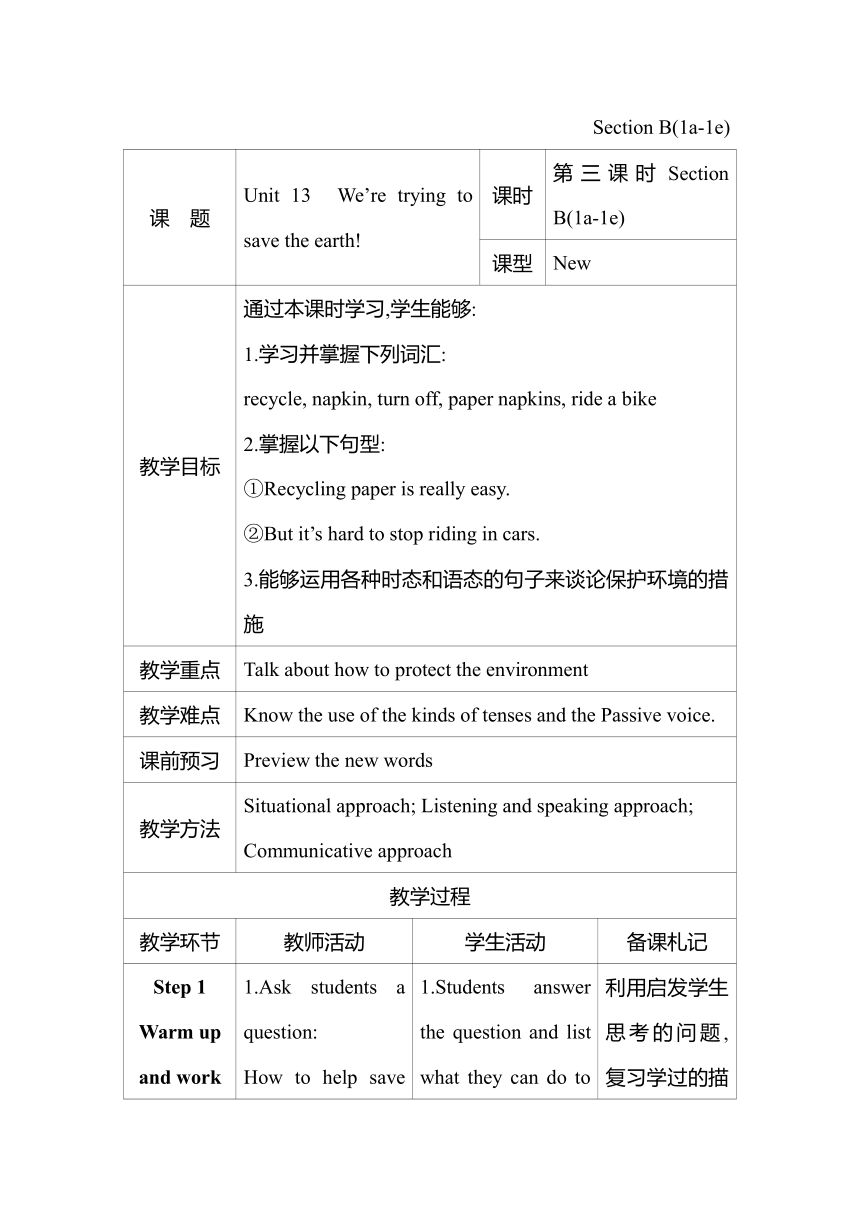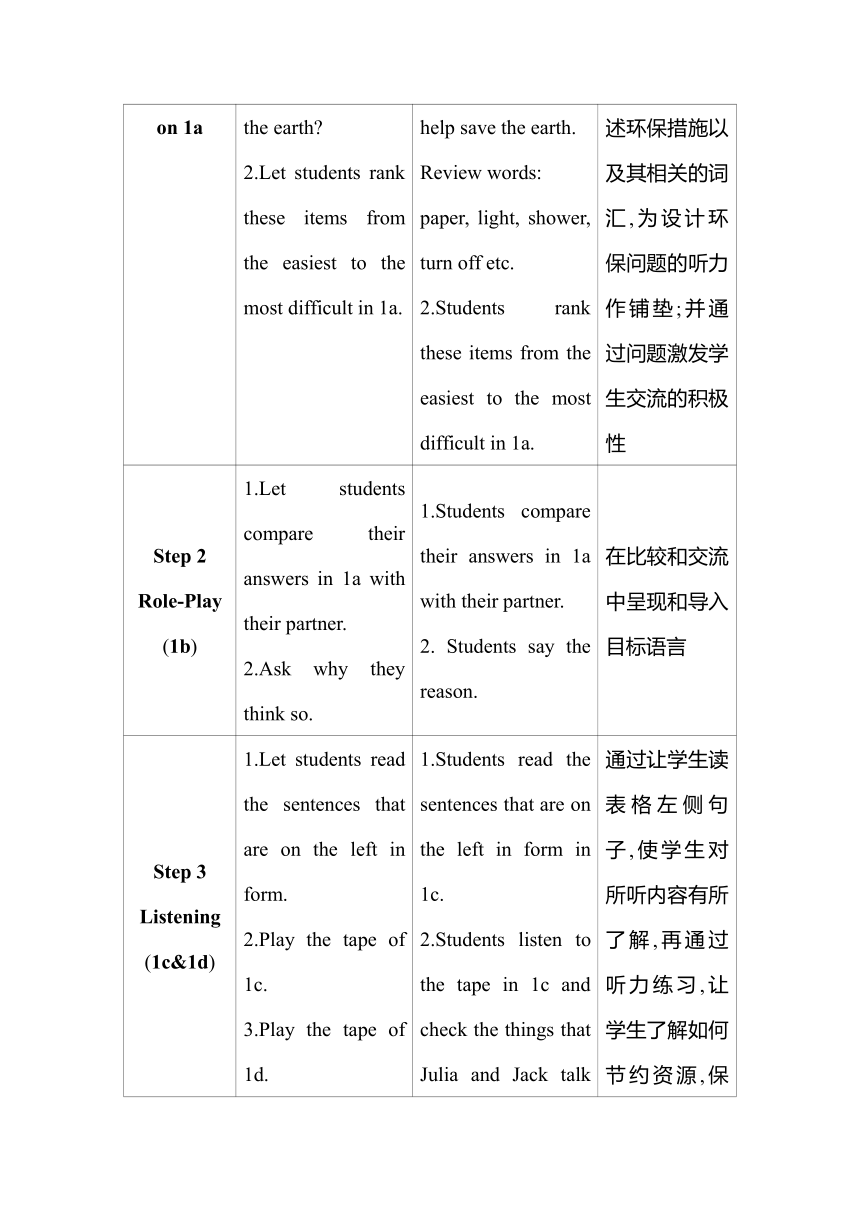Unit 13 We‘re trying to save the earth!Section B(1a-1e)教案(表格式) 2024-2025学年人教版英语九年级全一册
文档属性
| 名称 | Unit 13 We‘re trying to save the earth!Section B(1a-1e)教案(表格式) 2024-2025学年人教版英语九年级全一册 |

|
|
| 格式 | docx | ||
| 文件大小 | 21.1KB | ||
| 资源类型 | 教案 | ||
| 版本资源 | 人教新目标(Go for it)版 | ||
| 科目 | 英语 | ||
| 更新时间 | 2024-06-26 20:15:51 | ||
图片预览


文档简介
Section B(1a-1e)
课 题 Unit 13 We’re trying to save the earth! 课时 第三课时Section B(1a-1e)
课型 New
教学目标 通过本课时学习,学生能够: 1.学习并掌握下列词汇: recycle, napkin, turn off, paper napkins, ride a bike 2.掌握以下句型: ①Recycling paper is really easy. ②But it’s hard to stop riding in cars. 3.能够运用各种时态和语态的句子来谈论保护环境的措施
教学重点 Talk about how to protect the environment
教学难点 Know the use of the kinds of tenses and the Passive voice.
课前预习 Preview the new words
教学方法 Situational approach; Listening and speaking approach; Communicative approach
教学过程
教学环节 教师活动 学生活动 备课札记
Step 1 Warm up and work on 1a 1.Ask students a question: How to help save the earth 2.Let students rank these items from the easiest to the most difficult in 1a. 1.Students answer the question and list what they can do to help save the earth. Review words: paper, light, shower, turn off etc. 2.Students rank these items from the easiest to the most difficult in 1a. 利用启发学生思考的问题,复习学过的描述环保措施以及其相关的词汇,为设计环保问题的听力作铺垫;并通过问题激发学生交流的积极性
Step 2 Role-Play (1b) 1.Let students compare their answers in 1a with their partner. 2.Ask why they think so. 1.Students compare their answers in 1a with their partner. 2. Students say the reason. 在比较和交流中呈现和导入目标语言
Step 3 Listening (1c&1d) 1.Let students read the sentences that are on the left in form. 2.Play the tape of 1c. 3.Play the tape of 1d. 4.Explain the difficulties 1.Students read the sentences that are on the left in form in 1c. 2.Students listen to the tape in 1c and check the things that Julia and Jack talk about. 3.Students listen to the tape in 1d and check Julia is doing now, the things she will do in the future and the things she would never do. 通过让学生读表格左侧句子,使学生对所听内容有所了解,再通过听力练习,让学生了解如何节约资源,保护环境
续表
教学环节 教师活动 学生活动 备课札记
Step 4 Role-Play (1e) Let students make a conversation using the information from the chart above and say what is true for them. Students make a conversation using the information from the chart above and say what is true for them. 在听力练习的基础上,进行编对话表演 ,开展有实际意义的交际运用活动
Step 5 Summarize Guide the students to summarize use of the kinds of tenses and passive voice Summarizeuse of the kinds of tenses and passive voice 培养学生探究、归纳总结能力
Step 6 Consolidation 教师设置巩固检测练习: Ⅰ.用所给词的适当形式填空 1.This is my twin sister, Lucy. Not only she but also I am (be)good at drawing. 2.Stop smoking (smoke). It’s bad for your health. 3.Recycling (recycle) water is good for the environment. 4.You should take the bag when shopping(shop). Ⅱ.完成句子 1.当你离开房间时,请关灯 Please turn off the light when you leave the room. 2.循环利用纸很容易。 It’s easy to recycle paper. 3.你不应该开车去上班。 You shouldn’t drive your car to work. 独立完成检测练习,进行自我评价 通过检测练习,便于学生了解自己对本节课的词汇、句型、语法等的掌握情况
Step 7 Homework 1.Recite new words and phrases。 2.Make a list how to save the earth.
板书设计 Section B (1a-1e) 1.New words:recycle, napkin, turn off, paper napkins, ride a bike 2.Structures: ①Recycling paper is really easy. ②But it’s hard to stop riding in cars.
教学反思 在本节课的教学活动设计中,重点围绕听说活动创设丰富的语境,设置循序渐进的学习任务,充分发挥学生的主体作用,引导学生合作学习、自主探究,重视“预习——展示——练习——反馈”的学习过程
续表
资料链接 垃圾的分类及处理方法 生活垃圾一般可分为四大类:可回收垃圾、厨房垃圾、有害垃圾和其他垃圾。目前常用的垃圾处理方法主要有综合利用、卫生填埋、焚烧和堆肥。 可回收垃圾包括纸类、金属、塑料、玻璃等,通过综合处理回收利用,可以减少污染,节省资源。如每回收1吨废纸可造好纸850千克,节省木材300千克,比等量生产减少污染74%;每回收1吨塑料瓶可获得0.7吨二级原料;每回收1吨废钢铁可炼好钢0.9吨,比用矿石冶炼节约成本47%,减少空气污染75%,减少97%的水污染和固体废物。 厨房垃圾包括剩菜剩饭、骨头、菜根菜叶等食品类废物,经生物技术就地处理堆肥,每吨可生产0.3吨有机肥料。 有害垃圾包括废电池、废日光灯管、废水银温度计、过期药品等,这些垃圾需要特殊安全处理。 其他垃圾包括除上述几类垃圾之外的砖瓦陶瓷、渣土、卫生间废纸等难以回收的废弃物,采取卫生填埋可有效减少对地下水、地表水、土壤及空气的污染。 有专家说,垃圾是地球上唯一在增长的资源,也是放错了地方的资源。我们也常说要“变废为宝”。但是如果没有各种垃圾资源化利用的应用技术,垃圾还是垃圾,从来也不会自动成为“宝”。20世纪80年代以来,我国垃圾生产能源和回收再利用技术得到迅速发展。1吨废玻璃经机械化工艺处理后可生产出2万个啤酒瓶或相当于1个篮球场面积的窗玻璃;废塑料经回收利用后,可以变成原油,再从中提炼出柴油、汽油;约占城市生活垃圾总量65%-70%的厨余、果皮垃圾则可动用生化技术和专门的机器“吃进”,利用微生物发酵原理,在24小时内就可将垃圾就地变成颗粒型或粉状的肥料或饲料,供公共绿地使用或供市民家庭养花。 垃圾中可利用部分成为循环再生资源后,剩下的废物如何最终处置 怎样防止二次污染,让垃圾寿终正寝、安静无害地进入“坟墓” 这些问题将随着科学技术的发展和先进工艺的采用而逐步得到解答。 焚烧是一种城市垃圾的高温处理工艺,在850-1 000摄氏度的焚烧炉炉膛内,垃圾通过燃烧,其中的化学活性成分被充分氧化,留下的无机组分成为熔渣被排出,在此过程中垃圾的体积得到缩减,其易腐的性质得到了充分的改变。一般而言,垃圾在焚烧时将依次经历脱水、脱气、起燃、燃烧、熄火等几个步骤。 利用微生物降解城市有机固体废物的方法称为生物处理法,一般又称堆肥法。根据处理过程中起作用的微生物对氧气要求的不同,有机废物处理可分为好氧堆肥法(高温堆肥)和厌氧堆肥法两种。 城市生活垃圾中因含有一定量的有机质,经自然界广泛分布、种类繁多的微生物作用,通过生物化学变化,能将不稳定的有机物转化为较稳定的腐殖质。城市垃圾制成堆肥,实际是一种古老而实用的方法,也是我国和一些发展中国家传统处理和利用城市垃圾的方式。 土地填埋是从传统的堆放和填地处理发展起来的一项城市生活垃圾最终处理技术,其实质是将垃圾铺成一定厚度的薄层,加以压实,并覆盖土壤。城市生活垃圾填埋后,其中的有机易生物降解物质在厌氧条件下产生大量的甲烷气体,将其收集后,可用于发电或供热,使废物得以资源化利用,同时又可避免过度积聚带来的潜在危害。
课 题 Unit 13 We’re trying to save the earth! 课时 第三课时Section B(1a-1e)
课型 New
教学目标 通过本课时学习,学生能够: 1.学习并掌握下列词汇: recycle, napkin, turn off, paper napkins, ride a bike 2.掌握以下句型: ①Recycling paper is really easy. ②But it’s hard to stop riding in cars. 3.能够运用各种时态和语态的句子来谈论保护环境的措施
教学重点 Talk about how to protect the environment
教学难点 Know the use of the kinds of tenses and the Passive voice.
课前预习 Preview the new words
教学方法 Situational approach; Listening and speaking approach; Communicative approach
教学过程
教学环节 教师活动 学生活动 备课札记
Step 1 Warm up and work on 1a 1.Ask students a question: How to help save the earth 2.Let students rank these items from the easiest to the most difficult in 1a. 1.Students answer the question and list what they can do to help save the earth. Review words: paper, light, shower, turn off etc. 2.Students rank these items from the easiest to the most difficult in 1a. 利用启发学生思考的问题,复习学过的描述环保措施以及其相关的词汇,为设计环保问题的听力作铺垫;并通过问题激发学生交流的积极性
Step 2 Role-Play (1b) 1.Let students compare their answers in 1a with their partner. 2.Ask why they think so. 1.Students compare their answers in 1a with their partner. 2. Students say the reason. 在比较和交流中呈现和导入目标语言
Step 3 Listening (1c&1d) 1.Let students read the sentences that are on the left in form. 2.Play the tape of 1c. 3.Play the tape of 1d. 4.Explain the difficulties 1.Students read the sentences that are on the left in form in 1c. 2.Students listen to the tape in 1c and check the things that Julia and Jack talk about. 3.Students listen to the tape in 1d and check Julia is doing now, the things she will do in the future and the things she would never do. 通过让学生读表格左侧句子,使学生对所听内容有所了解,再通过听力练习,让学生了解如何节约资源,保护环境
续表
教学环节 教师活动 学生活动 备课札记
Step 4 Role-Play (1e) Let students make a conversation using the information from the chart above and say what is true for them. Students make a conversation using the information from the chart above and say what is true for them. 在听力练习的基础上,进行编对话表演 ,开展有实际意义的交际运用活动
Step 5 Summarize Guide the students to summarize use of the kinds of tenses and passive voice Summarizeuse of the kinds of tenses and passive voice 培养学生探究、归纳总结能力
Step 6 Consolidation 教师设置巩固检测练习: Ⅰ.用所给词的适当形式填空 1.This is my twin sister, Lucy. Not only she but also I am (be)good at drawing. 2.Stop smoking (smoke). It’s bad for your health. 3.Recycling (recycle) water is good for the environment. 4.You should take the bag when shopping(shop). Ⅱ.完成句子 1.当你离开房间时,请关灯 Please turn off the light when you leave the room. 2.循环利用纸很容易。 It’s easy to recycle paper. 3.你不应该开车去上班。 You shouldn’t drive your car to work. 独立完成检测练习,进行自我评价 通过检测练习,便于学生了解自己对本节课的词汇、句型、语法等的掌握情况
Step 7 Homework 1.Recite new words and phrases。 2.Make a list how to save the earth.
板书设计 Section B (1a-1e) 1.New words:recycle, napkin, turn off, paper napkins, ride a bike 2.Structures: ①Recycling paper is really easy. ②But it’s hard to stop riding in cars.
教学反思 在本节课的教学活动设计中,重点围绕听说活动创设丰富的语境,设置循序渐进的学习任务,充分发挥学生的主体作用,引导学生合作学习、自主探究,重视“预习——展示——练习——反馈”的学习过程
续表
资料链接 垃圾的分类及处理方法 生活垃圾一般可分为四大类:可回收垃圾、厨房垃圾、有害垃圾和其他垃圾。目前常用的垃圾处理方法主要有综合利用、卫生填埋、焚烧和堆肥。 可回收垃圾包括纸类、金属、塑料、玻璃等,通过综合处理回收利用,可以减少污染,节省资源。如每回收1吨废纸可造好纸850千克,节省木材300千克,比等量生产减少污染74%;每回收1吨塑料瓶可获得0.7吨二级原料;每回收1吨废钢铁可炼好钢0.9吨,比用矿石冶炼节约成本47%,减少空气污染75%,减少97%的水污染和固体废物。 厨房垃圾包括剩菜剩饭、骨头、菜根菜叶等食品类废物,经生物技术就地处理堆肥,每吨可生产0.3吨有机肥料。 有害垃圾包括废电池、废日光灯管、废水银温度计、过期药品等,这些垃圾需要特殊安全处理。 其他垃圾包括除上述几类垃圾之外的砖瓦陶瓷、渣土、卫生间废纸等难以回收的废弃物,采取卫生填埋可有效减少对地下水、地表水、土壤及空气的污染。 有专家说,垃圾是地球上唯一在增长的资源,也是放错了地方的资源。我们也常说要“变废为宝”。但是如果没有各种垃圾资源化利用的应用技术,垃圾还是垃圾,从来也不会自动成为“宝”。20世纪80年代以来,我国垃圾生产能源和回收再利用技术得到迅速发展。1吨废玻璃经机械化工艺处理后可生产出2万个啤酒瓶或相当于1个篮球场面积的窗玻璃;废塑料经回收利用后,可以变成原油,再从中提炼出柴油、汽油;约占城市生活垃圾总量65%-70%的厨余、果皮垃圾则可动用生化技术和专门的机器“吃进”,利用微生物发酵原理,在24小时内就可将垃圾就地变成颗粒型或粉状的肥料或饲料,供公共绿地使用或供市民家庭养花。 垃圾中可利用部分成为循环再生资源后,剩下的废物如何最终处置 怎样防止二次污染,让垃圾寿终正寝、安静无害地进入“坟墓” 这些问题将随着科学技术的发展和先进工艺的采用而逐步得到解答。 焚烧是一种城市垃圾的高温处理工艺,在850-1 000摄氏度的焚烧炉炉膛内,垃圾通过燃烧,其中的化学活性成分被充分氧化,留下的无机组分成为熔渣被排出,在此过程中垃圾的体积得到缩减,其易腐的性质得到了充分的改变。一般而言,垃圾在焚烧时将依次经历脱水、脱气、起燃、燃烧、熄火等几个步骤。 利用微生物降解城市有机固体废物的方法称为生物处理法,一般又称堆肥法。根据处理过程中起作用的微生物对氧气要求的不同,有机废物处理可分为好氧堆肥法(高温堆肥)和厌氧堆肥法两种。 城市生活垃圾中因含有一定量的有机质,经自然界广泛分布、种类繁多的微生物作用,通过生物化学变化,能将不稳定的有机物转化为较稳定的腐殖质。城市垃圾制成堆肥,实际是一种古老而实用的方法,也是我国和一些发展中国家传统处理和利用城市垃圾的方式。 土地填埋是从传统的堆放和填地处理发展起来的一项城市生活垃圾最终处理技术,其实质是将垃圾铺成一定厚度的薄层,加以压实,并覆盖土壤。城市生活垃圾填埋后,其中的有机易生物降解物质在厌氧条件下产生大量的甲烷气体,将其收集后,可用于发电或供热,使废物得以资源化利用,同时又可避免过度积聚带来的潜在危害。
同课章节目录
- Unit 1 How can we become good learners.
- Section A
- Section B
- Unit 2 I think that mooncakes are delicious!
- Section A
- Section B
- Unit 3 Could you please tell me where the restroom
- Section A
- Section B
- Unit 4 I used to be afraid of the dark.
- Section A
- Section B
- Unit 5 What are the shirts made of?
- Section A
- Section B
- Review of Units 1-5
- Unit 6 When was it invented?
- Section A
- Section B
- Unit 7 Teenagers should be allowed to choose their
- Section A
- Section B
- Unit 8 It must belong to Carla.
- Section A
- Section B
- Unit 9 I like music that I can dance to.
- Section A
- Section B
- Unit 10 You're supposed to shake hands.
- Section A
- Section B
- Review of Units 6-10
- Unit 11 Sad movies make me cry.
- Section A
- Section B
- Unit 12 Life is full of the unexpected
- Section A
- Section B
- Unit 13 We're trying to save the earth!
- Section A
- Section B
- Unit 14 I remember meeting all of you in Grade 7.
- Section A
- Section B
- Review of Units 11-14
